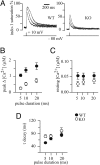T-tubule disorganization and defective excitation-contraction coupling in muscle fibers lacking myotubularin lipid phosphatase
- PMID: 19846786
- PMCID: PMC2773964
- DOI: 10.1073/pnas.0900705106
T-tubule disorganization and defective excitation-contraction coupling in muscle fibers lacking myotubularin lipid phosphatase
Abstract
Skeletal muscle contraction is triggered by the excitation-contraction (E-C) coupling machinery residing at the triad, a membrane structure formed by the juxtaposition of T-tubules and sarcoplasmic reticulum (SR) cisternae. The formation and maintenance of this structure is key for muscle function but is not well characterized. We have investigated the mechanisms leading to X-linked myotubular myopathy (XLMTM), a severe congenital disorder due to loss of function mutations in the MTM1 gene, encoding myotubularin, a phosphoinositide phosphatase thought to have a role in plasma membrane homeostasis and endocytosis. Using a mouse model of the disease, we report that Mtm1-deficient muscle fibers have a decreased number of triads and abnormal longitudinally oriented T-tubules. In addition, SR Ca(2+) release elicited by voltage-clamp depolarizations is strongly depressed in myotubularin-deficient muscle fibers, with myoplasmic Ca(2+) removal and SR Ca(2+) content essentially unaffected. At the molecular level, Mtm1-deficient myofibers exhibit a 3-fold reduction in type 1 ryanodine receptor (RyR1) protein level. These data reveal a critical role of myotubularin in the proper organization and function of the E-C coupling machinery and strongly suggest that defective RyR1-mediated SR Ca(2+) release is responsible for the failure of muscle function in myotubular myopathy.
Conflict of interest statement
The authors declare no conflict of interest.
Figures




References
-
- Pierson C, Tomczak K, Agrawal P, Moghadaszadeh B, Beggs AH. X-linked myotubular and centronuclear myopathies. J Neuropathol Exp Neurol. 2005;64:555–564. - PubMed
-
- Laporte J, et al. A gene mutated in X-linked myotubular myopathy defines a new putative tyrosine phosphatase family conserved in yeast. Nat Genet. 1996;13:175–182. - PubMed
-
- Laporte J, et al. MTM1 mutations in X-linked myotubular myopathy. Hum Mutat. 2000;15:393–409. - PubMed
Publication types
MeSH terms
Substances
Grants and funding
LinkOut - more resources
Full Text Sources
Other Literature Sources
Medical
Molecular Biology Databases
Research Materials
Miscellaneous

